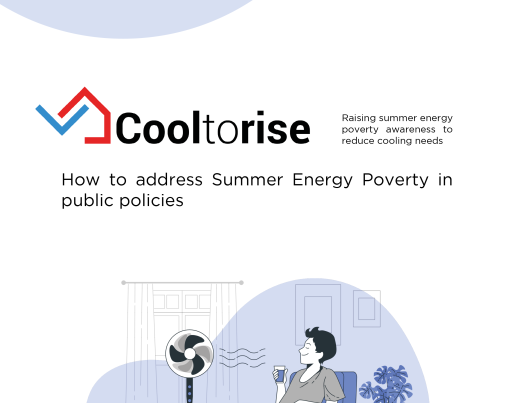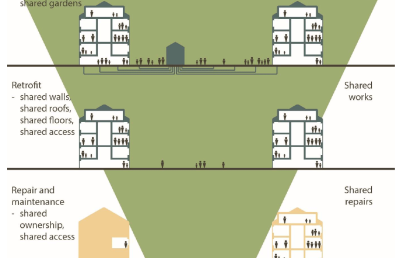
Recommendations on How to address Summer Energy Poverty in public policies

Recommendations on How to address Summer Energy Poverty in public policies
One of the main objectives of CoolToRise is raising awareness of summer energy poverty but also to identify ways to address it. Following that purpose is the aim of the first policy brief drafted in the framework of the project.
CoolToRise value includes not only the development of the project itself but also the fact that it aims to incorporate its experiences, results and strategies into policymaking. Recognizing the importance of policy development in guiding actions at different levels, this initial Policy Brief provides stakeholders with key guidelines for designing policies to address summer energy poverty. In order to tackle this, this document is structured according to three sections covering first summer energy poverty measurement; second impact on wellbeing conditions and urban scale and finally health impact.
There’s a well-known obstacle in shifting from awareness of a specific issue (like summer energy poverty) to the practical implementation of strategies, whether in private or public sectors. The goal of this policy brief is to bridge the gap between awareness and action, providing guidance for initial steps in implementing policies to tackle summer energy poverty. Despite some level of awareness and knowledge regarding summer energy poverty being considered achieved, this policy brief also aims to delve deeper into this topic and seeks a broadened perspective that includes all the nuances.
Measuring summer energy poverty
Regarding measurement, and taking into account that there is an absence of a common definition for summer energy poverty, Member States have the opportunity (and the need) to establish their own definition. It is important that these definitions are based on contextual knowledge and tailored to individual national contexts. The next step suggested by the policy brief is to measure summer energy poverty. This measurement will help to establish the current extend of the problem (and its baseline) allowing the impact of policies or strategies designed to address summer energy poverty to be monitored. To this end, a review of the current indicators used for measurement should be conducted. This review could translate into indicators that monitor housing conditions or access to energy and include specific questions related to summer indoor comfort or about the use of cooling systems. Additionally, it is important to consider the perspectives and experiences of households by identifying cultural aspects, acknowledging territorial differences (by mapping experiences and local initiatives) and identifying household strategies for coping with summer energy poverty (such as different uses of the public/open spaces).
Wellbeing conditions and urban scale
There are several differences between winter and summer energy poverty and one of them is that, during summertime, people have a wider range of low-energy consumption behaviors that can help them be more comfortable. This is because summer well-being conditions, unlike in winter, are a little bit less dependent on building insolation or conditioning systems. Additionally, in summer, the urban microclimate conditions are a huge factor in comfort because, depending on them, passive strategies used by households could vary their effectiveness.
This should be considered when designing public policies. The policy brief makes some recommendations related to these aspects, such as:
collecting qualitative data about households’ strategies by carrying out surveys and compiling data (on user behavior, socio-economic profiles, different heat-coping trends, passive strategies, adaptive measures, building use and energy supply)
using monitoring urban heat island and microclimatic conditions to consider local differences in future public policies.
support urban cooling measures to mitigate urban heat island and to improve the possibility for the households to use passive strategies and have climatic shelters. This may include urban cooling plans spanning from the city to the building scale.
Health impact
The temperature rise due to climate change has health implications, particularly for vulnerable population groups. The policy brief points out that including the vulnerability component in energy poverty policy measures is critical for informed decision-making and the development of enhanced policies. For that matter, the recommendations are to identify and characterize the most vulnerable groups, integrate policies that go beyond financial aid and which include social, health, and urban scopes, the elimination of historical debts related to the unpaid households’ bills (to avoid a progressive increase in interests), and adopts a comprehensive approach that includes the participation of civil organizations, public administration, private sector and academic sector.
This is a summary of the contents of the policy brief, which is now available for download
2023-how-to-address-summer-energy-poverty-in-public-policies-latest.pdf
English (1.71 MB - PDF)
